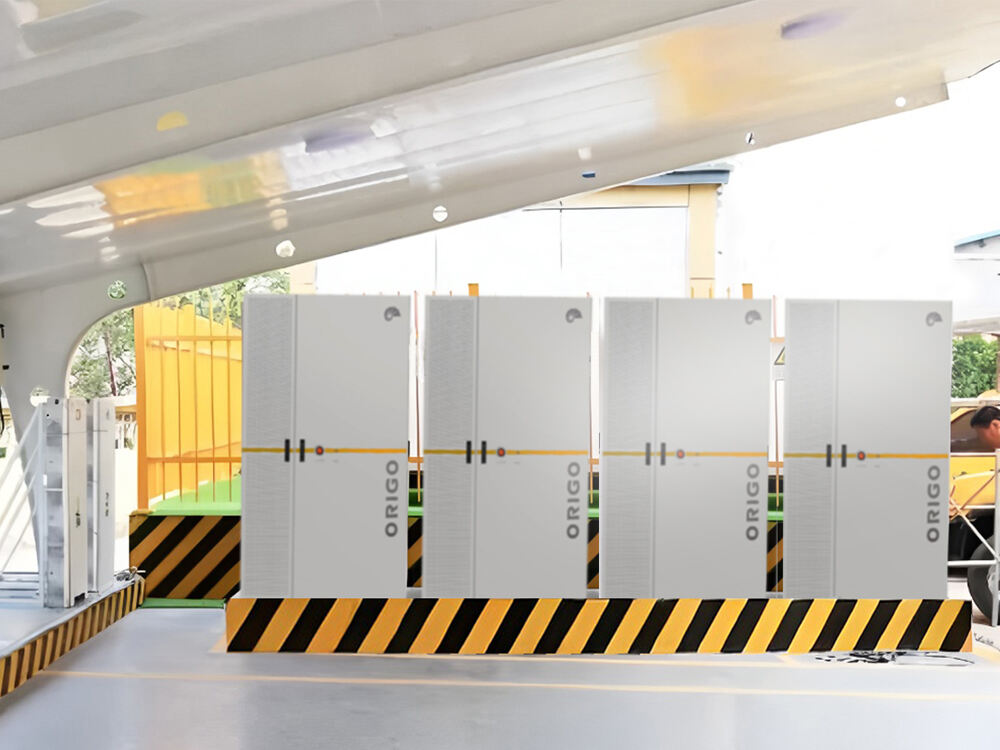Understanding Commercial and Industrial Energy Storage Systems
What Are Battery Energy Storage Systems for C&I?
Commercial and industrial battery storage systems, often called BESS, basically work by storing electricity so it can be used when needed. They're becoming really important for businesses because they help smooth out those annoying power fluctuations from the grid, cut down on those expensive peak demand fees, and make it easier to incorporate solar panels and other green energy options. Most of these modern installations rely on lithium-ion batteries connected to smart control systems. These controls figure out when to charge and discharge based on what's happening with electricity prices and how much power the facility actually needs at any given moment. Some companies have reported saving thousands just by timing their energy usage better with these systems in place.
Key Components of Commercial and Industrial Energy Storage
Three core elements define these systems:
- Battery banks: Typically lithium-ion or advanced flow batteries designed for high-cycle efficiency
- Power conversion systems: Inverters that manage AC/DC transitions with 95–98% efficiency
- Energy management software: Algorithms that automate load shifting and demand response
The Role of Lithium-Ion Batteries in Modern C&I Applications
Lithium-ion technology dominates C&I energy storage due to its high energy density (150–200 Wh/kg) and lifespan exceeding 10,000 cycles. These batteries support compact installations while maintaining over 90% round-trip efficiency—essential for facilities leveraging daily cycling to benefit from time-of-use electricity rates.
The Principle of Peak Shaving in Energy Management
Peak shaving works by storing energy in batteries so facilities don't pull as much power from the grid when rates go through the roof, sometimes jumping anywhere between 40 to 70 percent higher. When those expensive demand spikes hit, companies discharge what they've saved instead of paying for that short burst of maximum consumption. Most utility bills include charges based on the single worst 15 minute stretch of power usage during each month. Lithium ion batteries react almost instantly to keep energy consumption below certain limits set by the facility manager. This quick response time gives them a major edge compared to older alternatives such as diesel generators which take longer to ramp up or down.
Case Study: Peak Shaving in Manufacturing Facilities
A small to medium sized factory cut its demand charges down by around 22 percent, which translates to roughly $18k saved every year, after putting in place a 500 kW battery system with 3 MWh storage capacity. The monitoring showed something interesting: over two thirds of those demand charges were actually coming from just under 150 hours of really high usage throughout the whole year. So they started using stored power at strategic times during these peak periods, effectively bringing their overall electricity consumption down so it stayed beneath those expensive pricing tiers. Looking at industry reports from Illinois in 2023, companies doing similar things typically see between 15 and 30 percent drops in their commercial energy costs simply by managing those peak usage spikes.
Measuring Impact: Demand Charge Reduction Using Battery Systems
Key metrics for evaluating peak shaving success include:
| Measurement | Typical Range | Financial Impact |
|---|---|---|
| Peak demand reduction | 15–35% | $0.50–$2.50/kW monthly |
| Discharge cycle efficacy | 92–98% | 2–5 year payback periods |
Facilities with over 1 MW baseload and variable production schedules benefit most. A recent analysis of 120 C&I sites found that 78% achieved ROI within four years despite upfront battery costs. With modern forecasting, discharge windows can now be predicted with up to 90% accuracy, maximizing utilization.
Time-of-Use Arbitrage: Cutting Energy Costs with Off-Peak Charging
How Time-of-Use Pricing Creates Savings Opportunities
Time-of-Use (TOU) pricing lets companies take advantage of the price gap between off-peak and peak hours when electricity costs can swing anywhere from 30% to almost half more expensive. Commercial and industrial energy storage solutions typically fill up their batteries during those cheaper nighttime hours and then release stored power back into the system when prices spike during busy daytime periods. The whole approach really shines with dynamic pricing agreements that change rates according to what's happening on the grid right now. These smart contracts make it possible for businesses to automatically optimize when their systems charge and discharge, saving money while still meeting operational needs.
Real-World Example: Energy Savings in a Distribution Center
One mid size distribution center managed to slash their yearly energy costs by almost 20% simply by moving around 40% of their day time power usage with some lithium ion battery storage. They set up their energy management system so it would release stored electricity during those peak hours between 2 and 6 in the afternoon when rates jump up, which saved them roughly ninety two thousand dollars on demand charges throughout the year. Similar setups across both ERCOT and CAISO areas typically see their investment money back within five years or so, thanks to combining the savings from buying low and selling high with extra income from helping stabilize the grid when needed.
When Off-Peak Storage Fails to Deliver ROI: Key Limitations
Time of Use (TOU) arbitrage works best when there's a big gap between prices. For example, something like $0.08 per kilowatt hour during off peak times compared to $0.32 at peak hours makes it worthwhile. But this doesn't help much in places with flat rate pricing or where demand charges dominate the bill. What about battery life? Well, over time batteries degrade and their performance drops. Studies indicate that lithium ion systems typically lose around 15 to 20 percent capacity after going through 5,000 charge cycles. That means the savings start to shrink pretty seriously past year seven. Small facilities running irregular schedules or those operating under 200 kW often get better results from basic efficiency upgrades instead of spending money on energy storage solutions.
Smart Energy Management: AI and Integrated Control Systems
The Role of Smart Controls in Commercial and Industrial Energy Storage
Smart control systems powered by artificial intelligence can adjust energy distribution dynamically, cutting down on wasted electricity when demand is low by roughly 18 to 22 percent according to industry estimates. The way these systems work involves looking at past usage patterns through machine learning algorithms. They then redirect stored energy toward essential operations whenever electricity rates are highest, and focus on recharging from renewable sources when rates drop. Research published last year in the journal Energy and AI Integration Studies suggests that combining forecasting tools with lithium ion battery storage has helped businesses save around $2,100 per month on their average demand charges. Of course, actual savings will vary depending on specific circumstances and local utility pricing structures.
Integrated Energy Management Systems for Maximum Efficiency
Modern platforms unify three operational layers:
- Real-time equipment load monitoring
- Weather-adjusted renewable generation forecasts
- Automated demand-response coordination with utilities
Research from Hybrid Energy System Analysis shows integrated systems shorten ROI timelines by 14 months compared to standalone storage. Cross-functional data sharing—like aligning HVAC operation with solar production—reduces grid reliance and enhances overall efficiency.
How Real-Time Data Lowers Power Expenses Through Optimization
Granular, second-by-second tracking of voltage and consumption allows AI controllers to make micro-adjustments that accumulate into meaningful savings. One Midwest manufacturer saved $74,000 annually by implementing fine-tuned load-shifting protocols driven by real-time data. These incremental gains yield 2–3% monthly savings—equivalent to powering 12–18 assembly-line robots annually through reclaimed energy.
Calculating ROI and Long-Term Financial Benefits of C&I Energy Storage
Key Metrics for Evaluating ROI in Battery Energy Storage Systems
When looking at finances, there are three main things people usually check out. First off, Net Present Value or NPV shows what kind of savings we're talking about over time after accounting for inflation. Then there's Internal Rate of Return (IRR), which basically tells us how profitable something is each year. And finally, the payback period lets us know when our money will come back from whatever we invested initially. Take this real world scenario as an illustration: imagine a system that lasts around ten years with an impressive 15% IRR. According to some recent research from BloombergNEF in their 2023 report, such a setup could actually save about $450k at a facility running on 500 kilowatts worth of power.
Impact of Falling Lithium Battery Prices on Project Economics
Lithium battery costs have dropped 80% since 2013, reaching $98/kWh in 2023 (BloombergNEF). This decline reduces capital expenditures by $120–$180/kWh compared to 2018 levels, boosting IRR by 4–6 percentage points for mid-sized deployments.
Five-Year Financial Projection for a Mid-Sized Industrial Facility
A 1 MW/2 MWh system installed today at $45/kWh reaches breakeven in 3.2 years, delivering:
- $210,000 annual savings from peak shaving
- $85,000 yearly earnings from TOU arbitrage (charging at $0.08/kWh, discharging at $0.22/kWh)
- $340,000 in total incentives (ITC + state rebates)
By Year 5, cumulative net savings reach $2.1 million—37% higher than projections from 2020, largely due to declining battery prices.
Balancing High Upfront Costs with Long-Term Operational Savings
Although C&I energy storage requires an initial investment of $180–$300/kWh, facilities recover costs through:
- 60–90% reductions in demand charges (primary savings driver)
- 25% lower energy costs via time-of-use arbitrage
- 7–12% annual ROI from ancillary grid services such as frequency regulation and voltage support
With U.S. electricity prices rising at 4.6% annually (U.S. EIA 2023), most systems achieve positive cash flow within 48 months and deliver 12–15 years of sustained cost control.
FAQ
What are the main benefits of Commercial and Industrial (C&I) energy storage systems?
C&I energy storage systems help businesses smooth out power fluctuations, reduce peak demand fees, and integrate renewable energy sources such as solar panels. They enable facilities to optimize their energy usage and benefit from time-of-use electricity rates.
How do lithium-ion batteries contribute to energy storage for businesses?
Lithium-ion batteries are favored for their high energy density and long lifespan. They provide efficient energy storage, with over 90% round-trip efficiency, and have a quick response time compared to alternatives like diesel generators.
What is peak shaving and how does it save money?
Peak shaving is a strategy that stores energy in batteries to reduce the amount of power drawn from the grid during peak demand times, effectively lowering demand charges. This allows businesses to avoid high energy tariffs associated with the maximum consumption periods.
How significant is Time-of-Use (TOU) arbitrage in saving energy costs?
TOU arbitrage takes advantage of lower energy rates during off-peak periods by charging batteries when electricity is cheaper and discharging them when rates are higher. This results in significant cost savings, particularly in regions with dynamic pricing agreements.
What role does AI play in smart energy management systems?
AI-powered smart control systems dynamically adjust energy distribution, reducing wastage and optimizing energy use. They analyze historical data to make informed decisions on when to store and discharge energy, considering real-time electricity rates and renewable energy availability.
Table of Contents
- Understanding Commercial and Industrial Energy Storage Systems
- The Principle of Peak Shaving in Energy Management
- Case Study: Peak Shaving in Manufacturing Facilities
- Measuring Impact: Demand Charge Reduction Using Battery Systems
- Time-of-Use Arbitrage: Cutting Energy Costs with Off-Peak Charging
- Smart Energy Management: AI and Integrated Control Systems
- Calculating ROI and Long-Term Financial Benefits of C&I Energy Storage
-
FAQ
- What are the main benefits of Commercial and Industrial (C&I) energy storage systems?
- How do lithium-ion batteries contribute to energy storage for businesses?
- What is peak shaving and how does it save money?
- How significant is Time-of-Use (TOU) arbitrage in saving energy costs?
- What role does AI play in smart energy management systems?


